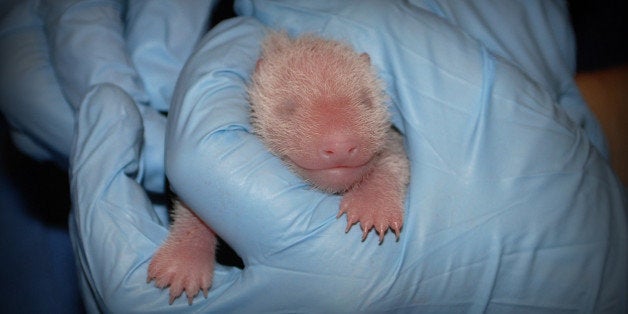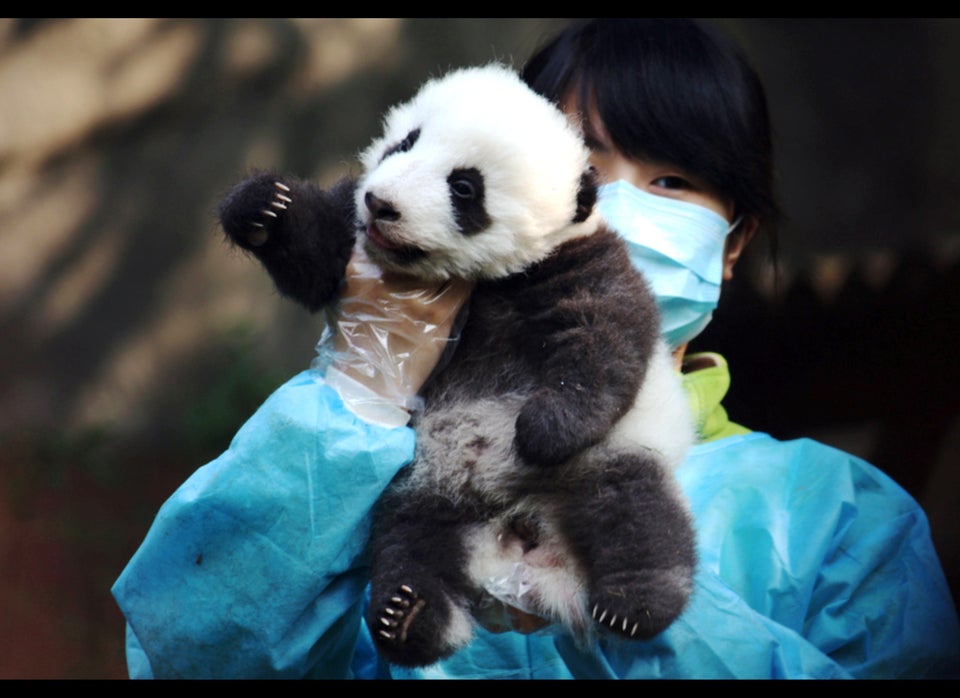
The panda baby born at the National Zoo in Washington just over a week ago was pink, wriggly and almost impossibly small -- about a third of a pound at its first checkup. This tiny creature's mother, Mei Xiang, weighs more than 230 pounds.
Pandas are considered to be "endangered," with about 1,600 in the wild and another few hundred in captivity (some estimate there are more like 3,000 pandas in the wild). Their low birth rates, males' reluctance to mate in captivity (keepers have even tried panda porn to get them in the mood) and high mortality rates (about a quarter of males and a fifth of females die in their first year, by some accounts; others put the figure higher) aren't helping.
Traditionally, baby pandas aren't even named until they are 100 days old. These creatures can face demise during their early lives in what seems like countless ways. In Washington in 2012, Mei Xiang gave birth to a cub, which died after 6 days from liver and lung problems. In Tokyo, where a 6-day-old cub died from pneumonia after its mother's milk got in its airway, officials said that 60 to 70 percent of newborn pandas die within their first week -- sometimes by being crushed by their mothers.
Here's Conservation International's description of what can befall the rare and delicate newborns:
At birth, a panda cub is helpless. It takes considerable effort on the mother’s part to raise it. A newborn weighs three to five ounces. Pink, hairless, and blind, the cub is 1/900th the size of its mother. Except for a marsupial (such as the kangaroo or opossum), panda babies are the smallest newborn mammals relative to their mother's size.
Cubs don’t open their eyes until they are six to eight weeks of age, and are immobile until three months. A cub may nurse for up to nine months before it can eat bamboo. A cub is nutritionally weaned at one year, but not socially weaned for up to two years. Infant mortality is lower in the wild than in captivity, estimated at around 40 percent.
The perilous nature of being born so tiny raises one big question: Why are panda newborns so small?
Because of bamboo, said wildlife biologist Dajun Wang, who has not only studied wild pandas in China but also has a video of himself with a panda youngster in the wild on YouTube:
Itty bittiness is "definitely a result of evolution of millions of years," Wang recently told The Huffington Post. "It is [a] kind of breeding strategy."
The strategy, Wang explains, is this: Pandas subsist almost entirely on bamboo, which has very little nutrition. Grown pandas have to eat as much as 80 pounds of bamboo per day to meet their nutritional needs.
"It is easier for the animal to convert bamboo into milk than to convert bamboo into animal tissue," said Wang. But there are trade-offs. "A tiny baby needs more care from its mother, for nursing, keeping warm and to avoid predators. I believe it is kind of balance."
Then a question still remains: Why do pandas eat mostly bamboo, when, genetically, they are carnivores? (Yes, carnivores!)
And not only are they carnivorous, but according to one scientific paper, "Why Does the Giant Panda Eat Bamboo? A Comparative Analysis of Appetite-Reward-Related Genes among Mammals," pandas even lack the gene for properly digesting bamboo. Although bamboo is their chief, though not sole, foodstuff; pandas have been found eating meat -- a phenomenon Wang researching -- as well as honey, eggs and, on their 16th birthdays, fruitsicles shaped like cars:
Scientists have found that pandas lost the gene that would allow them to enjoy the taste of meat about 4.2 million years ago, which is around the time the animals also switched over to their bamboo diet; fossil records show pandas going mostly veg somewhere between 7 and 2 million years ago.
That helps answer the question of when pandas switched to their bamboo diet, but not why. "Nobody knows how they got involved [with a] bamboo diet and how they fixed this behavior in the species," said Wang. "That will be a big deal in evolution if somebody give a real answer."
Update, Sept. 3, 8:29 a.m.: Know who's not quite so teeny tiny anymore?
The National Zoo tweeted photos of Mei Xiang's new baby over the weekend -- this cub is still incredibly small, you can see in the pics, but you can also see some important developments:

